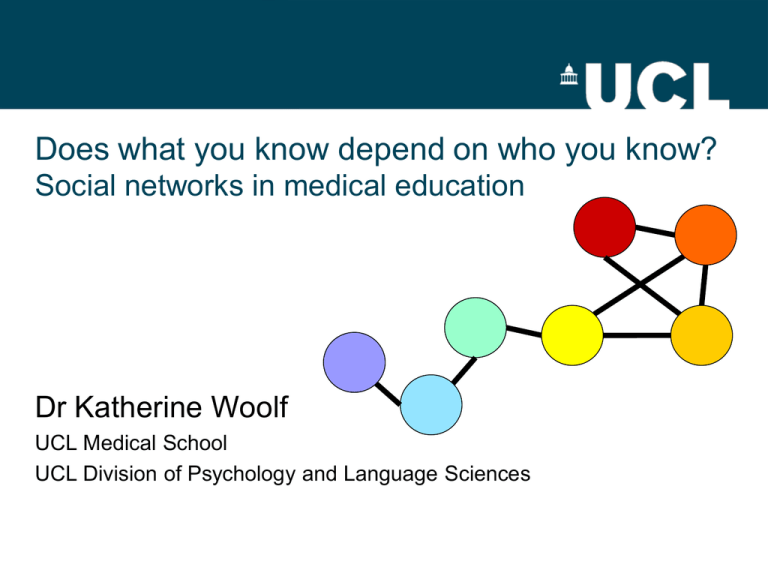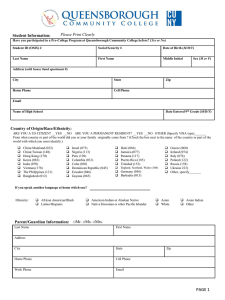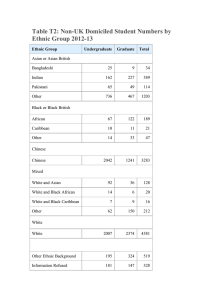
Does what you know depend on who you know?
Social networks in medical education
Dr Katherine Woolf
UCL Medical School
UCL Division of Psychology and Language Sciences
Humans are social beings
Influence of husband’s death on widow’s
health (1964)
Asch’s conformity experiments (1951)
But…
Modern scientific medical and psychological
research tends to focus on the individual
Advances in computing now enable studies
of large numbers of socially-related people
(networks)
Evolution of the
network of Twitter
users who exchange
messages 10 days
after meeting at a
camp on 15th May
2011 http://15m.bifi.es
UCL pilot study: Does performance “spread
through” medical student social networks?
Woolf, Potts, Patel, McManus. Under review, Medical Teacher
Medical schools as total institutions
(IC McManus, 2003)
Medical schools have expanded
From 100 – 120 per year to 300-400 per year
“Dunbar’s number”
150
In a year of 300, students cannot know every
other person in their year well
Who do they know?
Why those people and not others?
What effects might this have?
Research questions
Which factors influence friendship formation?
Are medical students’ friendships related to their
exam performance?
Measuring the social network
Questionnaire to Year 2 UCL medical students in
November 2009 (n=317)
List of all students in Year 2
Participants indicated which were their friends
Methods
From student records, collected data on student:
–
–
–
–
–
exam results (Years 1 and 2)
tutor group (randomly allocated start of Year 1)
campus (Year 1)
sex
ethnicity (19 categories white vs BME)
Prior to med school: sex and ethnicity
Year 1
Oct
Nov
Dec
Jan
Feb
Year 2
Mar
Random allocation
to tutor group (and campus)
Apr
May
Oct
Sit Year 1
exams
retrospective
Nov
Dec
Jan
Our study
questionnaire
Feb
Mar
Apr
May
Sit Year 2
exams
prospective
n=317 (mean number friends=19 SD=11)
Response rate 68% data on 100% students in Year 2 (undirected ties)
Friendship formation
How do friendships at the start of Year 2 relate to:
Year 1 exam scores
Campus
Tutor group
Small teaching group
Sex
Ethnicity
Network visualisation
n=317 (mean number friends=19 SD=11)
Year 1 quartiles
bottom
2nd
3rd
top
Campus
Whittington
Royal free
UCH
Sex
female
male
Ethnicity (white and BME)
white
BME
C-finder
Finds cliques in
a network
Visualisation of
cliques
Probability of selecting 14 BME students by chance
<0.0001
Largest clique (n=14)
Asian Indian
Asian Other
All n=10+ cliques (n=45)
Asian Indian
Asian Pakistani
Asian Other
Other
Black African
White
All n=7+ cliques (n=143)
Asian Indian
Asian Pakistani
Asian Other
Asian Bangladeshi
Black African
Black Caribbean
Chinese
Other
White
Network visualisation shows us…
Complex social network with clustering, especially
by ethnicity
Statistical social network analysis
Enables calculation of independent effects and
p values
– Factors relating to friendship formation
– Relationship between friendship ties and subsequent
exam performance
Social network analysis: Is network distance
related to similarity?
B:23
A:24
C
1 degree of separation
1 year difference
D
E
G
F
B
C
2 degrees of separation
A:24 3 years difference
D:21
E
G
F
B:23
C
A
3 degrees of separation
5 years difference
D
E
G
F:18
Our medical student study
Is network distance between each pair predicted
by similarity in:
– Year 1 exam grades, tutor group, small teaching group,
campus, ethnicity, sex
Is similarity of each pair’s subsequent Year 2
grades predicted by:
– network distance 7 months previously, taking into
account similarity on other factors
Statistical analysis
Multiple regression to calculate independent
effects
Permutation tests for calculation of p values
Closer network distance start of Year 2
predicted by:
same sex (p<0.0001)
same ethnicity (p<0.001)
same tutor group (p<0.0001)
same small group (p=0.003)
independent
effects
Similarity in end of Year 2 grades predicted
by:
Network distance (p=0.014)
i.e. closer pairs at the start of Year 2 ended up with
more similar Year 2 grades
even after taking into account their similarity in
Year 1 grades (p<0.0001) and on other factors
More similar
Year 1 grades
(May 2009)
.519
More similar
Year 2 grades
(May 2010)
(p<.0001)
Same
campus
Same Year 1
small group
.043
.020
(p=.0135)
(p=.0003)
Same Year 1
PDS group
.129
(p<.0001)
Same sex
.030
(p=.0001)
Same ethnicity
2 groups
.146
(p<.0001)
Same ethnicity
6 groups
Closer network
distance Year 2
(Nov 2009)
Summary of results
Students became friends with others from the
same sex and ethnic group
Random allocation to groups also encouraged
friendships
Friends ended up with more similar exam results
This evening’s talk
Introduction to social networks research
Data from a UCL pilot study
Implications of the findings, especially those
relating to ethnic equality in education
white
BME
Ethnicity findings are supported by previous
research… e.g.
“You find quite a lot of segregation…I don’t like
that – people look at me and they think … all my
friends are going to be Indian and I’m only
gonna, you know, talk to Indian people”
British Indian female 3rd yr medical student UCL (2006)
“A lot of Asian people sat at the back of the
lecture and that’s mainly because a lot of them
are part of the Islam society … People who are
black maybe join the African society so we get
to know each other. Lots of whites, they join the
sports societies”
British Black female 1st year medical student UCL (2010)
Methods
Suzanne
Vaughan, PhD student, Manchester
• Large UK medical school, 450 students per year, PBL
Setting • Undergraduate, 40% ‘ethnic minority’, 60% female
1
• 14 interviews, 4th year (clinical phase)
• ↑‘Ethnic minority’, UK-born only
2
• Social networks survey n=149
• 3rd year (clinical phase), approached in PBL groups
3
• 19 interviews, 3rd + 4th year
• Purposive sampling (ethnicity, gender, network)
PBL Egonetworks at Manchester (Vaughan)
Up to 10 people you interact with in activities important for your
academic success:
‘white’
‘Chinese’
‘Malaysian’
unknown
female
male
Why do these ethnic cliques exist?
Clustering is completely normal
(Gordon W Allport, The Nature of Prejudice, 1954)
So why care? Because cliques can lead to
stereotyping, prejudice and conflict
(Gordon W Allport, The Nature of Prejudice, 1954)
But could this happen at our medical
schools?
Highly educated
Care about others
Multicultural
Negative stereotyping of Asian medical
students exists (Woolf, Cave, Greenhalgh, Dacre,
BMJ 2008)
BME students, esp Asian
students perceived as:
Pushed into medicine
Less motivated by a
desire to help others
Good at bookwork
Poor at communicating
It’s possible that medical school ethnic
cliques lead to…
Creation and/or maintenance of stereotypes
Negative attitudes towards people, including
patients, from different ethnic groups
BME – white performance gap is unexplained
Found throughout higher education
Not explained by individual factors, including:
Socioeconomic group
Language
Learning habits
Can social networks help explain BME
student underperformance?
It’s possible if:
– Students learn from one another and BME groups have
less cultural or social capital
Less ‘capital’?
(Lempp & Seale, BMC Medical Education, 2006 – GKT)
Can social networks help explain BME
student underperformance?
It’s possible if:
– Students learn from one another and BME groups have
less cultural or social capital
– Negative stereotyping causes BME underperformance
(Steele & Aronson, 1995: “stereotype threat”)
What might medical schools do about this?
Intergroup contact reduces prejudice
(Pettigrew & Tropp, 2006)
1,017 citations (6th September 2011)
Example of how contact can reduce prejudice
“Before [the patient entered] we [had] a brief
chat about ‘who you are, where you come
from, where you’re up to, what are your
interests’….
Suddenly...my perception of her changed...
I didn’t just see a student, a-nother student,
another Indian student...I actually saw this
person ….
When patients came in it was just easy to
engage her” Female GP, white, UCL 2006
How can we encourage intergroup contact
between students in medical schools?
Randomly allocating students to groups can help
students break down ‘natural’ barriers
Make new students aware of what their natural
instincts might be, and what the consequences
might be, and what they can do about this
BMA report (2009)
3rd year student at Manchester (thanks to Suzanne Vaughan)
“I think religion has a bigger
role than ethnicity. Most of my
friends, those who live with me,
we're from a Muslim background
and we're holding strongly on to
that and so we get our interaction,
our social activity, what we do in
our life based on our religion.
Unfortunately here drinking is a
culture isn't it?”
Luqman (male, Malaysian)
How can we encourage intergroup contact in
medical schools?
?Consider:
Role of clubs and societies
Consequences of having social events based
around drinking alcohol
In summary
Social networks research can shine a light on a
previously unexplored area of the hidden
curriculum
Many potential far-reaching consequences
Much more work needed in this under-researched
area





